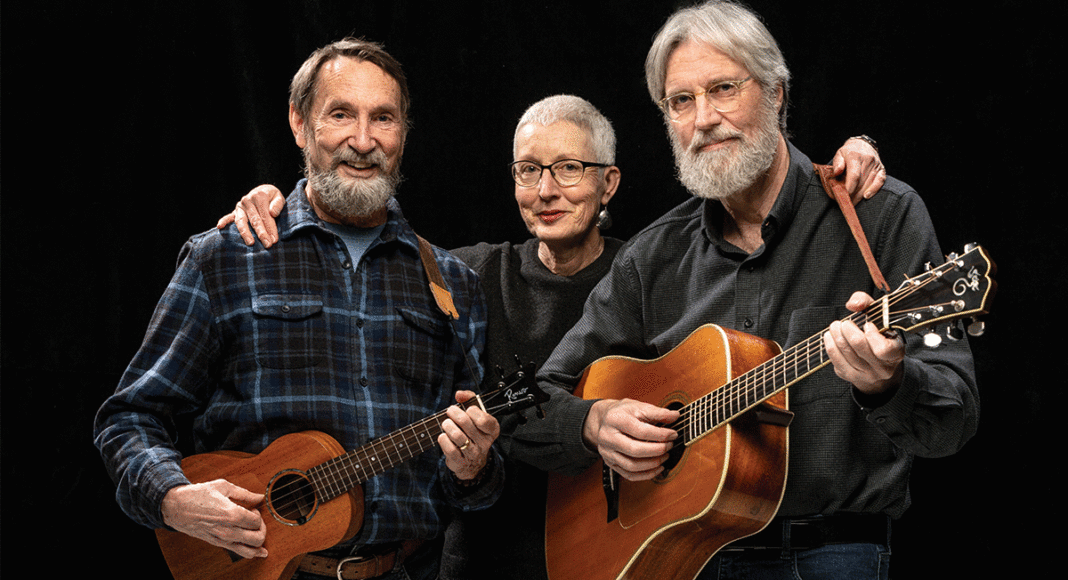Clear as spring water and and mellow as Kentucky bourbon, their voices take us back to a time and place somewhere in the American heartland. Working in close harmony through vintage bluegrass, Appalachian folk songs and classics by masters like Hank Williams, Bill Monroe and the Stanley Brothers, Sister Brothers casts a sweet spell.
Although their public concerts are rare, they’ve already won a cult following for a broad and haunting folkloric repertoire. Experience has produced the effortless harmonies of Dan Landry, Heidi Rentería and Jim MacKenzie—Landry singing with the Ariose Singers, and Rentería in countless singing camps and the UCSC Concert Choir. MacKenzie, who met Landry while singing Gregorian chants, started playing guitar and singing in barbershop quartets and trios as a teenager. At an Oregon singing camp in 2011, Landry and Rentería discovered how well their voices worked together.
“We invited Jim to come over and sing the following year,” Rentería recalls. “The trio format, supported by Jim’s guitar, quickly clicked, and the Sister Brothers were born.”
The three singers focus on music rooted in backcountry traditions where close, three-part harmonies are key—and, as Landry puts it, “full of memories of the singing of friends and family.” They work arrangements out collaboratively by ear. “Each of us takes turns at singing lead, and who sings which harmony part, above or below the melody line, changes from song to song,” says Rentería, who says she loves this music “most of all for the fabulous lyrics.”
“There’s such real emotion, because it’s about universal feelings,” she says. “It’s about feeling lonesome and blue and hearing a train at midnight. But some of the songs we sing are lighthearted, witty, even funny. I am really amazed that as different as our individual voices are, we have found that we can blend beautifully.”
MacKenzie, who plays guitar with the group, explains the vocal range spanned by the trio. “Dan sings the really high vocals. My range is bass through baritone to middle tenor. It’s a pretty broad range, but I can’t really reach that super-high vocal range that bluegrass singing especially calls for.” As for the versatile Rentería, “sometimes I’m singing the lowest part, sometimes the middle, more frequently the top line. We think that including solo and duet parts, passing around the lead and the harmony parts, and varying the accompaniment keeps our audience from getting bored.”
The music they make together is undeniably powerful. “I think the appeal of our music stems both from the emotional content of the songs we select to sing and from our close vocal harmonizing,” MacKenzie says, “As an adolescent and well into my 20s, I sang in duos and trios and loved it. Being able to do that again now has been an extremely gratifying and fulfilling experience,” he adds.
“Giving close attention to these songs and discovering new ways to use the voice,” says Landry, “reveals how flexible and expressive it can be.” Renteria sums up the joy of singing harmonies as “the physical breathing together, the intense being in the moment, listening to each other and to ourselves, trying different ways of treating a line or a word or a note, constantly influencing each other. Singing harmonies, you know you’re alive!”
All three singers bring fierce discipline, energy and miles of insight to this music that burrows deep into the heart of the American experience. And each agrees that it is the emotional depth of even the simplest tunes and plainest lyrics that casts Sister Brothers’ lingering spell.
Sister Brothers will perform a sit-down concert of American songs from the mid-1800s through the first half of the 20th century from songwriting masters like the Delmore Brothers, Bill Monroe, the Everly Brothers and more. Feb. 9, 3 p.m. r.blitzer Gallery, 2801 Mission St., Santa Cruz. Free. rblitzergallery.com.












